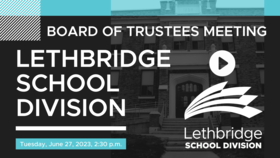Board of Trustees meet on June 27 for Regular Meeting

The Regular Meeting of Lethbridge School Division Board of Trustees will take place on Tuesday, June 27 at 2:30 p.m.
Members of the public are welcome to attend the meeting in person by visiting The Aakaipookaiksi Building (Education Centre) at 433-15 St. S. If you are unable to attend in person, Tuesday's meeting will also be available via livestream through the Division's YouTube channel, which can be found here: YOUTUBE.
The Regular Meeting begins at 2:30 p.m. At that time, members of the public will be admitted into the Education Centre. The maximum number of occupants in the public gallery seating is limited to 60. Once the Board Room has reached capacity, unfortunately, we will be unable to facilitate additional in-person attendance. Attendees will be invited to view the meeting online.
The Public Forum portion of the meeting is scheduled at 5 p.m. and will run until 5:15 p.m. Per policy, the Public Forum portion of the meeting will be a maximum of 15 minutes total. Individual speakers, (or groups), are limited to five minutes each. For example, if three presenters each choose to take their full five minutes, only those three presenters will be allowed to participate in the Public Forum. The Board will listen to and carefully consider the feedback given at the Public Forum and will provide a written response by the next regular Board meeting. As per meeting protocols, the Board will not provide an immediate response to Public Forum submissions at the Board meeting. The parameters for public forums are outlined in Policy 204.13, Public Presentations and Forums.
Given the 15-minute time limit, the Board held a random draw on Monday afternoon to determine the individuals who will participate in the Public Forum. Viviana Lartiga Castillo, Mike Richey and Heather Rowland were selected through the random name generator.
The Board would like to remind anyone attending the meeting of the following:
• We are happy to have you join us for the meeting. Regular Board meetings have established norms and protocols that ensure the meeting is respectful and effective. Anyone in attendance at the meeting is expected to follow the Board’s established protocols and norms, as outlined in Policy 204.2, Regular Board Meetings.
• There may be students in attendance at various times during the meeting. Any member of the public in attendance is expected to contribute to a safe, welcoming and respectful environment for our students.
• Lethbridge School Division employees will be working during the meeting. Any member of the public in attendance is expected to contribute to a safe, welcoming and respectful working environment for all Division employees.
The agenda can be found here AGENDA.
ADDITIONAL DETAILS:
This is a Board that wants to hear from and have public involvement. That valuable participation needs to happen in a proper, respectful process, in accordance with the opportunities that already exist. The Regular Board meeting is an opportunity to express topics of interest and concerns by: 1. Public Forum (as already described); 2. Public Presentations (which require 14 days notice).
In recognizing there is considerable interest is expressing perspectives surrounding Policy 502.2, please note this is not a new policy that has come forward. The format to make comments or to suggest changes is through the current processes that exists. Policy 502.2 was first created in 2016 and revised in 2018. There are processes in place to review policies. Policies are reviewed by a Policy Advisory Committee, and all stakeholders have representation, including parents, teachers, representatives from each CUPE group, representatives from the Division administration committee, the Superintendent and a parent representative. A Trustee chairs the meeting. Once the review starts, it is then sent out to each stakeholder group for feedback and input. For the parent group, the policy with revisions is sent out by email to School Council chairs, along with anyone that has requested to have their name stand on the email list. Feedback is then received and all feedback is brought to the Policy Advisory Committee for review, discussion and recommended changes. The recommended changes are then brought forward to the Board, at a public Board meeting. The Board debates, discusses and sometimes sends the policy back to the Policy Advisory Committee, or the Board passes the newly-revised policy into practice. Those with concerns regarding policy are asked to adhere to the process already in place.
Other ways to share concerns with the Board include:
- Email - Several parents, students, staff and the public have emailed Trustees. Those messages have been passed on to all Trustees.
- Community Conversations - These public gatherings have been held throughout the year on a nearly monthly basis. Trustees make themselves available to hear concerns, such as those brought forward at Division School Council, in addition to the positives and the successes students are having. This is a Board that does want to hear from its constituents, but also wants to ensure it is always done in a respectful manner.
- Phone calls and face-to-face conversations - As time is available, Trustees are available for phone calls or face-to-face conversations
- Each school has a designated Trustee assigned to it - You can use email, phone calls or an in-person meeting to communicate with the individual Trustee.
Other ways to have discussions about important student related topics:
- School Council meetings – School councils are a place for members of the community to consult with and offer advice to principals and school boards.
• School councils are a bridge between the school and the community
• focus on what is best for all students in the school
• consider the interests of all school stakeholders
• develop, maintain and reflect the culture of the school
• represent the parent voice in the school community. - Use the Channels of Communication – This includes communicating directly with your student’s teacher and/or administrative staff: Policy 1003.1 Channels of Communication and Disputes Resolution.











